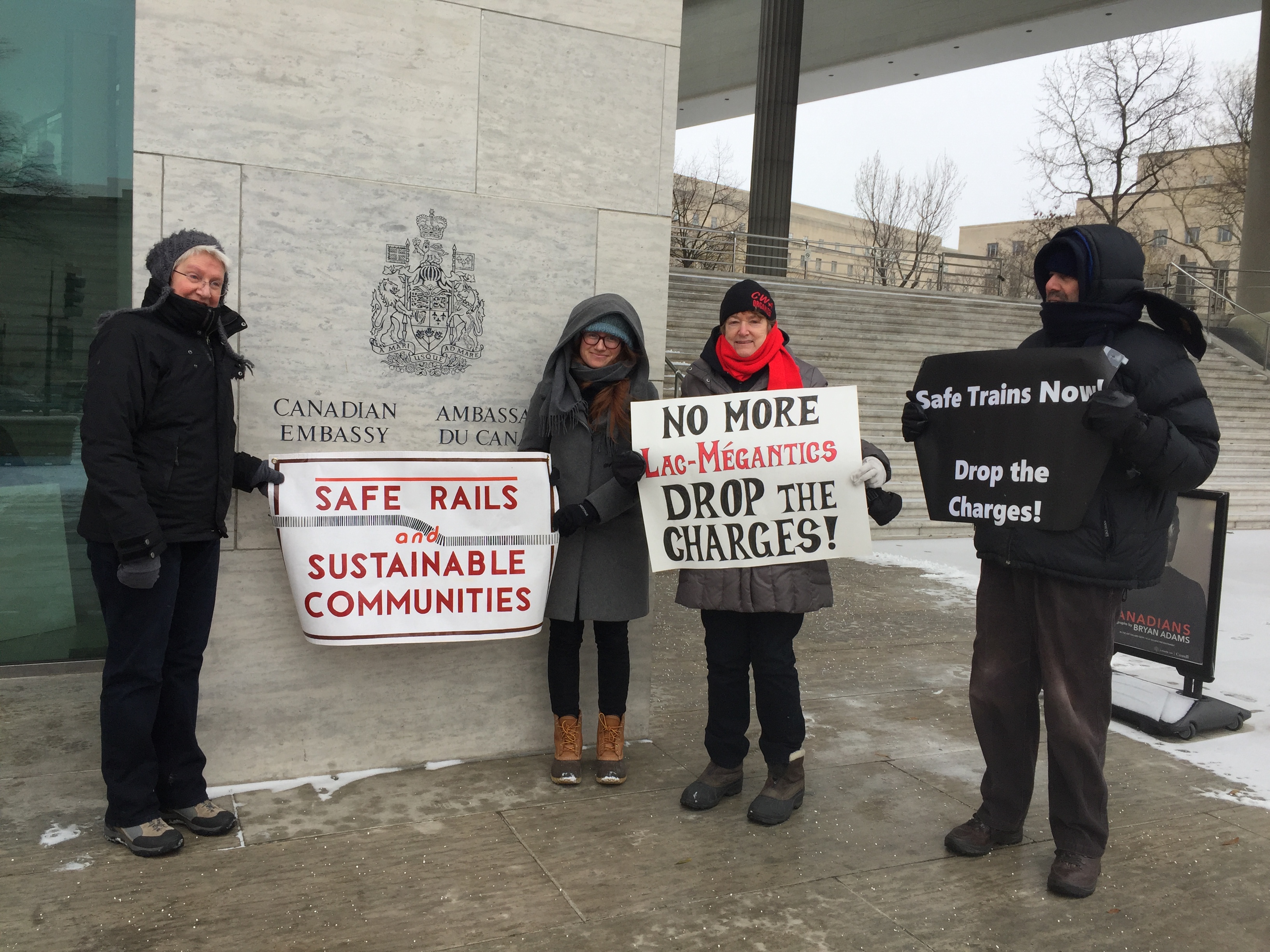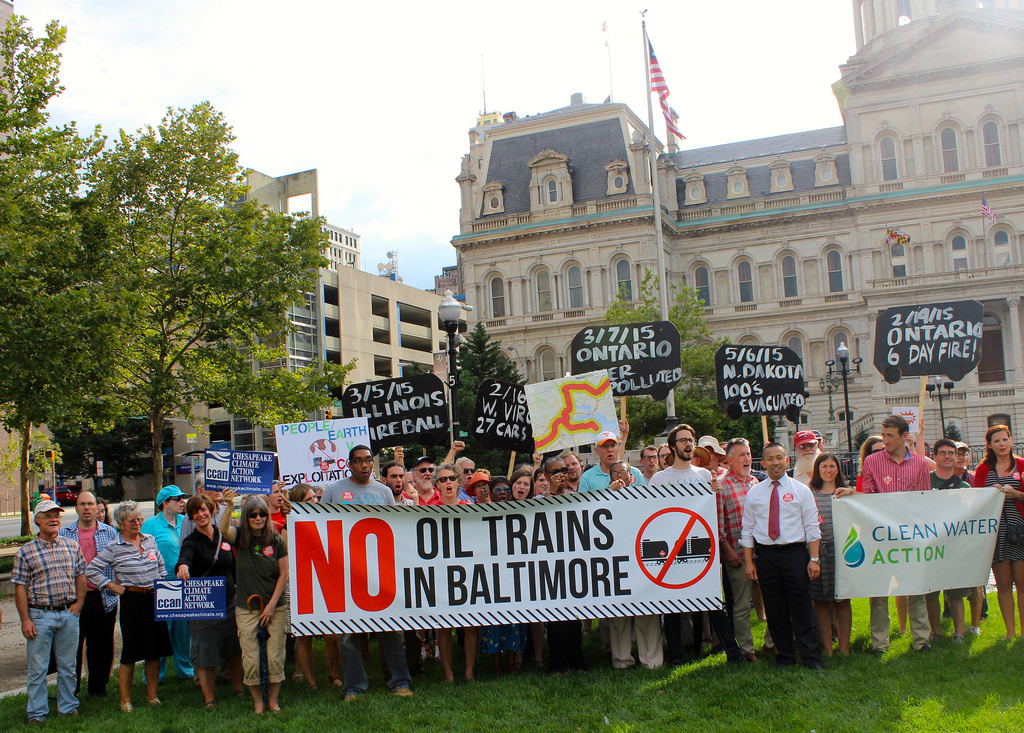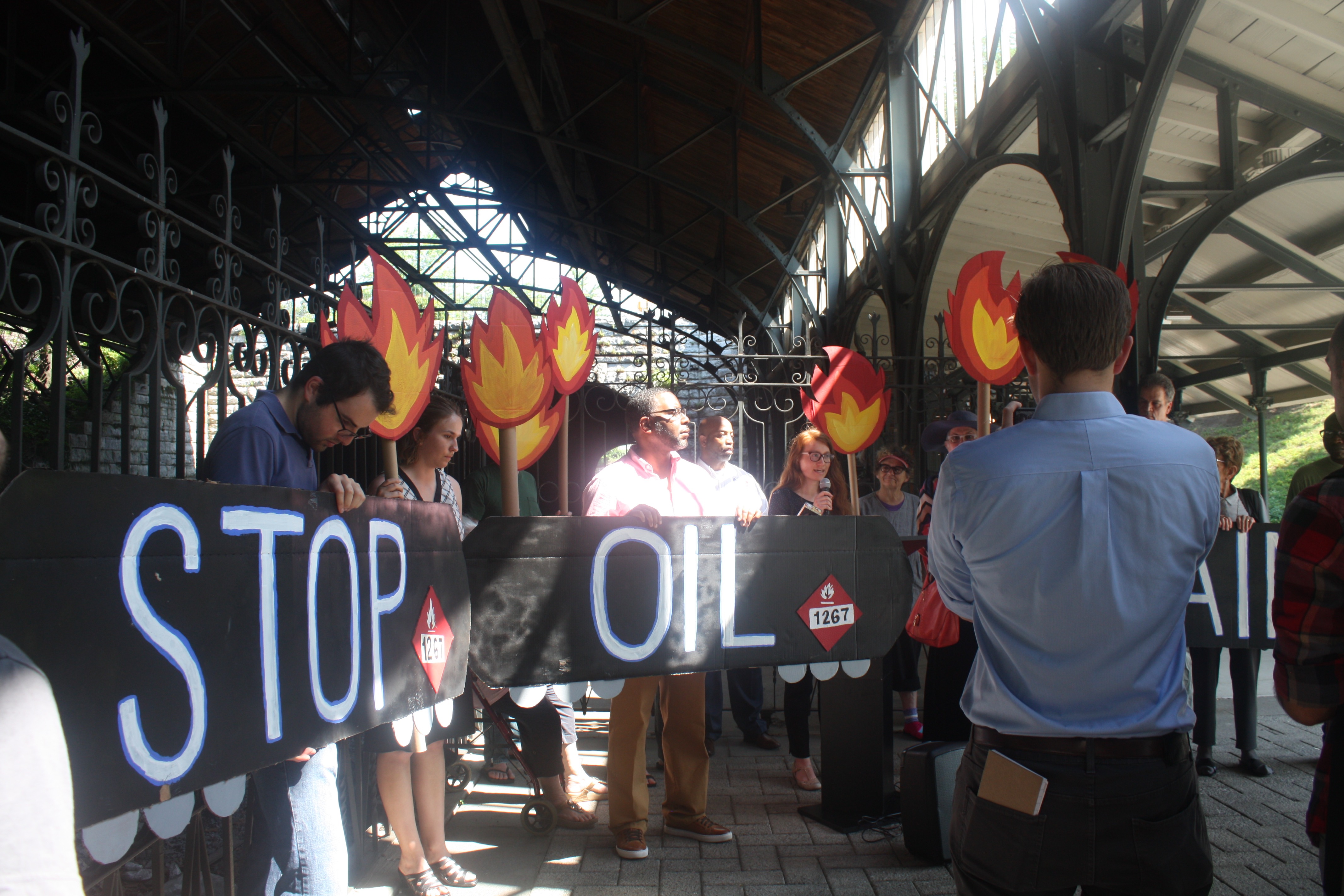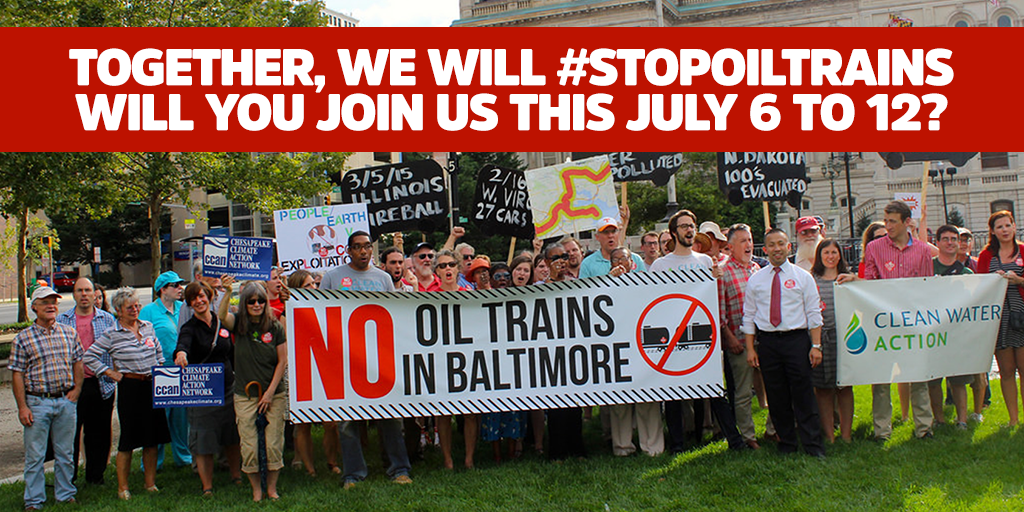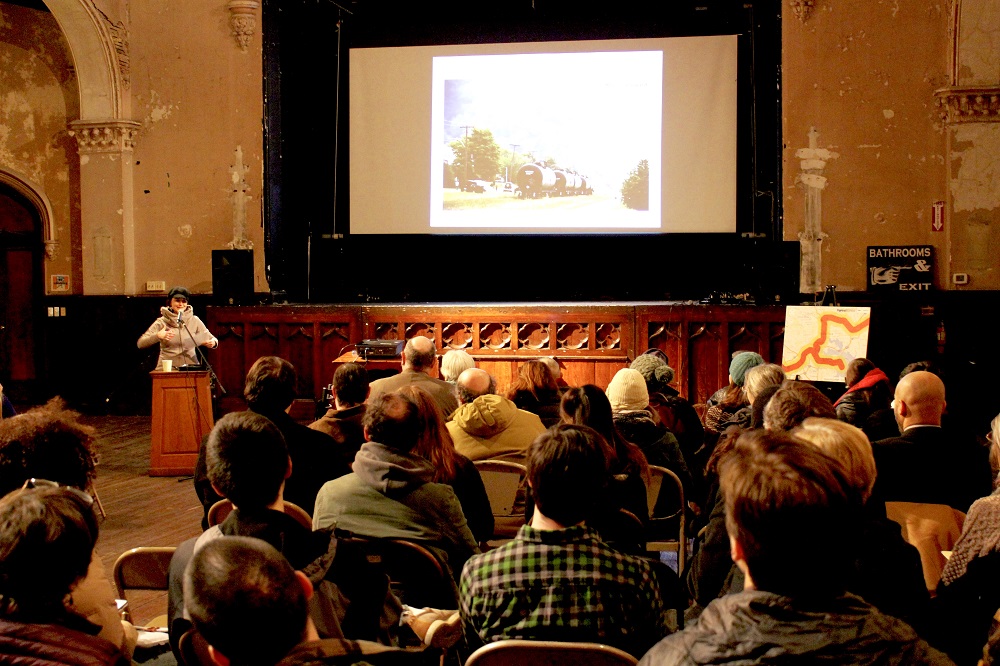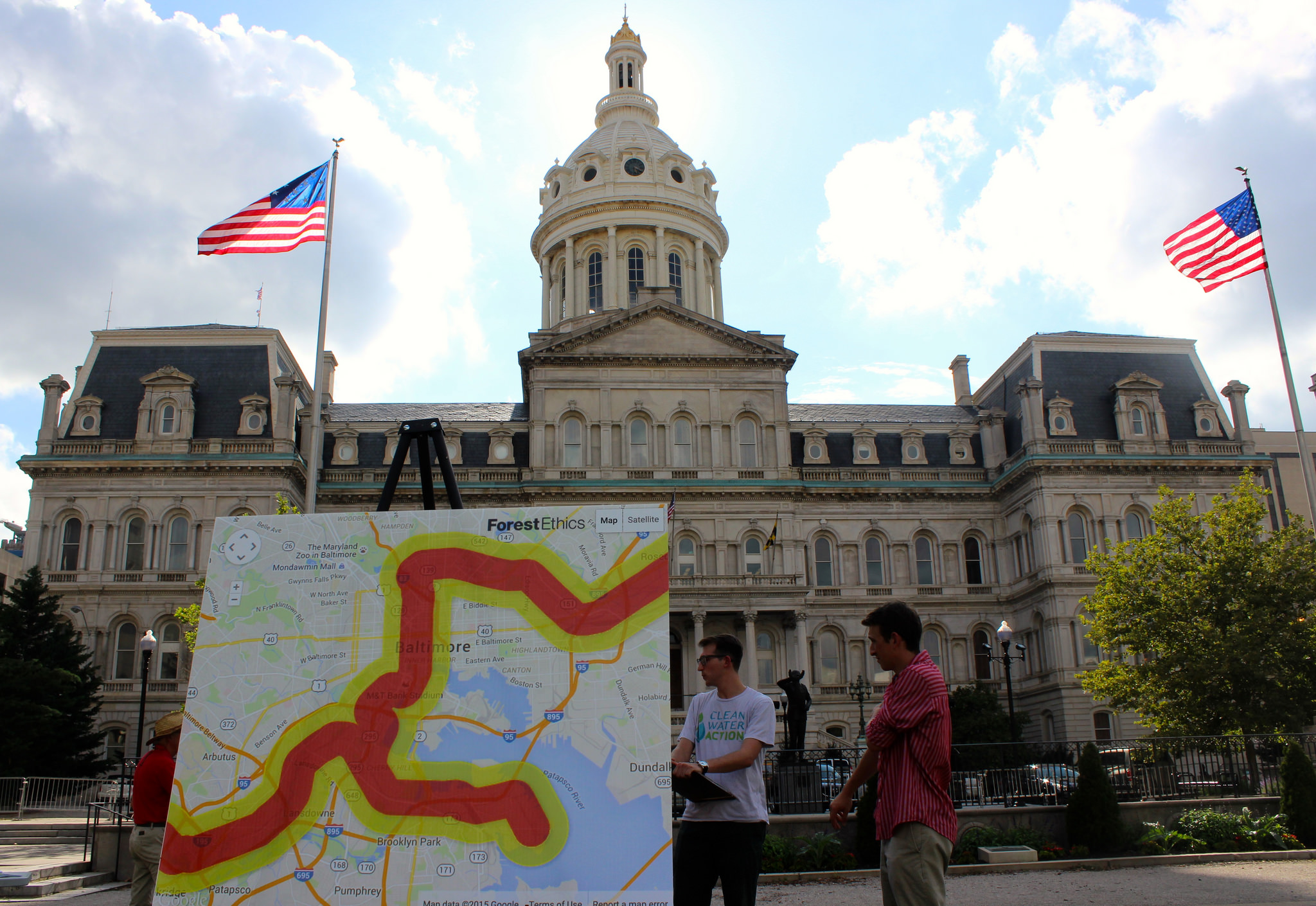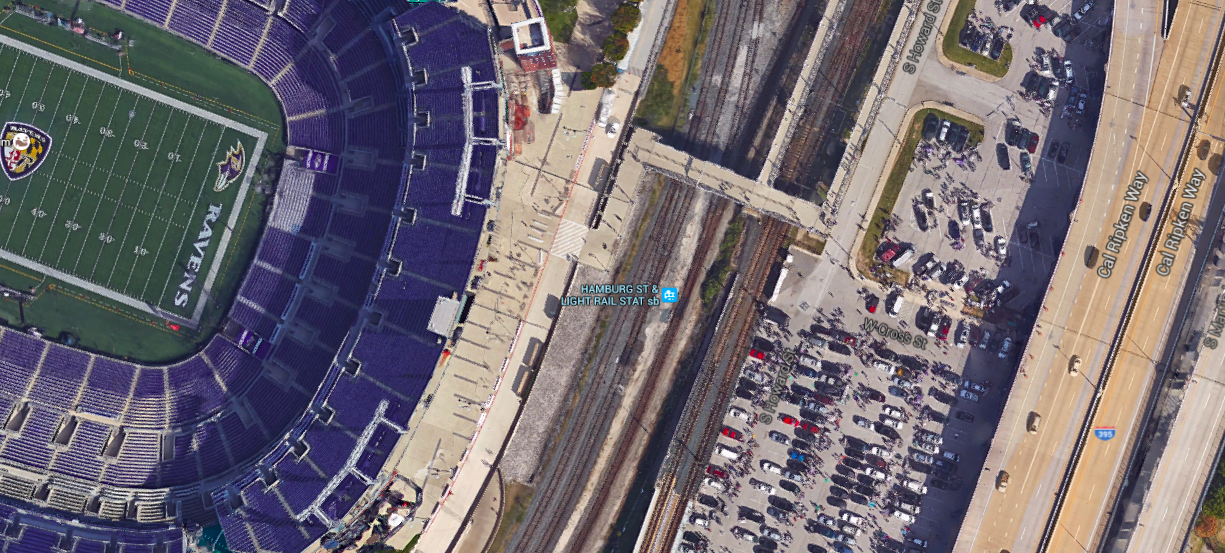Last week, a small but mighty group braved the bomb cyclone in DC to rally for rail safety outside the Canadian Embassy. We were there to stand in solidarity with the scapegoated rail workers currently on trial for the deadly 2013 crude oil train derailment in Lac-Megantic, Quebec.
On July 6, 2013, a freight train carrying 72 tank cars of crude oil derailed in the small town of Lac-Megantic. Many of the town’s residents were gathered at a local bar for a birthday party when the runaway train barreled into downtown a little after 1:00 in the morning. When the train derailed at a sharp curve in the tracks, its highly flammable cargo exploded and wrought devastation, killing 47 people, orphaning 27 children, destroying 44 buildings, and leaving 160 people homeless.
Over four years later, the criminal trials for this tragedy are about to conclude. Yet the wrong people are being blamed.
The rail company that operated the ill-fated train, Montreal Maine and Atlantic Railway Ltd. (MMA), is not being held accountable for its dangerous policies and poor safety regulations that made the derailment inevitable. Instead, rail workers Tom Harding and Richard Labrie each face one count of criminal negligence causing the death of 47 people in the Lac-Mégantic crash.
While the prosecution has focused on the number of hand brakes that engineer Harding applied on the train before parking it for the night, the Transportation Safety Board report on the disaster paints a more comprehensive picture. After reviewing the TSB report, a chemical engineer at the Université de Sherbrooke concluded, “the company has tolerated improper braking practices, did not provide appropriate braking practice and did not ensure the employees were properly trained and demonstrated that they understood the training.”
What else do we know about the conditions that led to the derailment? The train was illegally overloaded, weighing 2,800 tonnes over the legal limit. There was a mechanical breakdown on the locomotive two days before the derailment, but MMA officials allowed the train to operate anyway. And the inspector of the locomotive had little experience, only having begun inspecting trains solo a few weeks before.
Yet the policy that most rail safety advocates point to as the key culprit in this case is the inherently dangerous one-person crew practice imposed soon before the tragedy. To increase profits, rail companies like MMA have been decreasing crews from four, three, or two people to only one person. When MMA made this change, the only action the company took to protect that remaining one-person crew member was to require the installation of a mirror on the conductor’s side of the train.
That’s right: a mirror was expected to replace a second and even third skilled worker.
Though it is clear that lax regulations and unsafe railroad management policies led to the tragedy in Lac-Megantic, engineer Tom Harding and traffic controller Richard Labrie are facing exclusive blame for the incident. They face life in prison for a tragedy that their employer made inevitable by cutting corners. Further, if the workers are convicted of criminal negligence, the reckless policies and lack of regulatory oversight that caused the disaster will not be changed. The conditions that led to the tragedy in Lac-Megantic will remain the norm, continuing to put communities along rail lines in danger.
In Baltimore, we have an opportunity to make real progress in the fight against dangerous crude oil trains. In October, 11 members of the City Council introduced an ordinance to zone out new crude oil terminals, which will limit dangerous crude-by-rail traffic in the city while protecting our climate from this polluting crude oil.
Click here to learn more and take action with the CCAN Action Fund.
New Video Highlights the Advocates Fighting Bomb Trains in Baltimore
Local residents and advocates have been fighting explosive crude oil trains in Baltimore since 2014. From stopping a new crude oil terminal in 2015 to introducing a landmark piece of legislation zoning out all new and expanded crude oil terminals just last month, activists have made great strides in the fight to protect the city from bomb trains.
Watch the short documentary below to learn more about our campaign to stop bomb trains in Baltimore! Check it out! And after you watch, contact your Baltimore City Councilmember and urge them to support the Crude Oil Terminal Prohibition!
The video was made by Travis Edwards in conjunction with our partners at Clean Water Action and features South Baltimore community leaders Rodette Jones, Ann Robinson, and Keisha Allen.
Baltimoreans Call for Action on Oil Trains on Derailment Anniversary
On June 13, 2016, a freight train traveling from Philadelphia to Cumberland derailed inside the Howard Street Tunnel next to MICA’s campus. Twelve of the derailed cars were designed to carry liquefied petroleum gas but were thankfully empty at the time. The remaining car that derailed was carrying acetone. The incident took over 24 hours to clear.
At the time of last year’s derailment, I lived just a few blocks away and awoke that morning to numerous alerts about the incident from concerned friends. Knowing that explosive crude oil has traveled this exact route in Baltimore, I was terrified about the potential devastation due to a derailment. Thankfully, there were no injuries or leaks, and most of the cars that derailed were empty. But the incident begs the question, “what if?” What if that train had been carrying explosive crude oil?
Yesterday, residents of Baltimore’s crude oil train blast zone, MICA representatives, Councilwoman Mary Pat Clarke, and labor and environmental advocates rallied to commemorate the 1-year anniversary of this train derailment and to discuss the public health and safety threats posed to Baltimoreans by dangerous crude oil trains.
During the rally, MICA faculty member Valeska Populoh reflected on last year’s derailment: “The incident has raised my concerns about the transport of hazardous materials on these rail lines so close to our campus and the surrounding community, the potential threats to health and safety that these pose, as well as the potential for disruption of traffic and daily life in this central part of Baltimore in the event of another derailment.”

165,000 Baltimoreans live, work, and go to school in the oil train “blast zone” — the area that could be directly impacted if a crude oil train derailed and exploded. Baltimore has had too many close calls with freight trains. In addition to last year’s derailment next to MICA, there was the infamous 2001 derailment in the Howard Street Tunnel, which caused a fire and water main break that effectively shut down the city for a week. In 2013, a freight train exploded in Rosedale and broke windows, shook nearby buildings, and slowed traffic throughout the region. And in 2014, the retaining wall on 26th St collapsed, sending parked cars, streetlights, and large chunks of sidewalk onto the CSX tracks below.
All of these incidents occurred on the route that crude oil trains have been known to take through Baltimore and are examples of just how close Baltimore has come to a catastrophic incident.
During Tuesday’s rally, David McClure, President of the Amalgamated Transit Union Local 1300, said, “Each day our 2,500 MTA workers transport the people of Baltimore to work, school, the doctor, or wherever they need to go. And our riders’ safety is our number one priority. I repeat, it’s our number one priority. And now it’s time for the City Council to put the safety and health of the people first. It’s time to put a stop these trains from carrying dangerous crude oil and other hazardous cargo travelling through these densely-populated neighborhoods before we have a disaster on our hands.”
Ulysses Archie, an urban farmer and community advocate, spoke on Tuesday as a concerned father. He highlighted the forty Baltimore City Public Schools that are located within the blast zone and noted that tens of thousands of children, including his boys, are endangered by crude oil train traffic in the city.
The rally came a few days after members of the Baltimore City Council and Maryland General Assembly toured South Baltimore neighborhoods that are threatened by crude oil train traffic. On Friday, June 9th, community leaders concerned about the potential for a catastrophic explosion led the elected officials on a tour of Mt Winans, Westport, and Curtis Bay and saw some of the most vulnerable points in Baltimore’s infrastructure for a derailment and explosion.

While it is up to the federal government to ultimately ban the transport of crude-by-rail, local and state officials can take steps to protect Marylanders from this public health and safety threat. In Baltimore, the City Council can prevent the construction of new and the expansion of existing crude oil train terminals in order to limit oil train traffic within the city. Port cities across the country have been taking the lead on fighting fossil fuel infrastructure through zoning authority, and Baltimore can too. At the state level, the General Assembly can pass legislation focused on emergency preparedness, transparency, and proof of insurance for crude-by-rail incidents.

CCAN is working hard with our partners in the Baltimore City Council and in the Maryland General Assembly to protect Marylanders from crude-by-rail traffic. Sign the petition to the Baltimore City Council urging action and get involved with our local campaign!
Offshore Wind Is A Fair Development Opportunity In Baltimore
For far too long, Baltimore has been forced to bear the burden of failed development that pollutes the city, causes disproportionate health impacts, and forces residents out of their communities. But now, offshore wind presents the city with an opportunity to become a manufacturing hub for clean energy.
South Baltimore is host to a slew of polluting and dangerous developments, including a 200-acre coal pier, medical waste incinerator, and numerous chemical and pesticide plants. It is also home to a crude oil shipping terminal. “Bomb trains” carrying explosive crude oil from North Dakota travel through the city, and many stop at the NuStar Energy Storage Terminal in Fairfield to transfer oil from rail to barge in order to ship it to refineries in the Northeast.
From 2013 to 2014, over 100 million gallons of crude oil were transported into Baltimore by rail to be offloaded and shipped to refineries. Transporting crude by rail puts 165,000 people in the “blast zone” in Baltimore – the area that could be directly impacted if a train were to derail and explode. Bakken crude oil is highly volatile and transporting it by rail has had devastating consequences, most notably the 2013 derailment and explosion in Lac-Mégantic, Quebec that killed 47 people and leveled the town.
There have been close calls in Baltimore in recent years. Last June, a train carrying acetone derailed in the Howard Street Tunnel right next to the Maryland Institute College of Art (MICA) — my alma mater. A school parking lot was filled with emergency vehicles for over a week while the derailment was contained. Last month, eight cars on a CSX freight train derailed on a sharp curve in Frederick County. While nothing spilled, the train was carrying hazardous materials and was traveling the same route that crude oil trains have been known to take to reach Baltimore.
And two weeks ago, a fire broke out in a scrap yard in Fairfield just across the street from the oil train shipping terminal there. The fire was contained, but once again, Baltimoreans were faced with a terrifying “what if” scenario had the fire reached the terminal.
These close calls, along with the string of derailments, fires, and explosions caused by oil trains across the country, demonstrate that transporting crude by rail is an unacceptable gamble that endangers people who live, work, and go to school near the tracks.
Meanwhile, it is clear that Marylanders are ready for clean energy.
Last month, the state held two public hearings in Berlin and Annapolis where residents showed up in droves to voice their support for offshore wind farm proposals.
Throughout the three-hour hearing in Berlin, person after person got up in front of the packed auditorium to speak about how offshore wind will help clean Maryland’s air, provide a reliable source of renewable energy, and create thousands of jobs across the state. Union members were a strong presence at the hearing, from piledrivers to carpenters, all of whom stand to benefit from the potential manufacturing and construction jobs across the state. And as a Baltimorean, talk of repurposing Sparrows Point into a wind turbine manufacturing hub was particularly exciting.
Instead of continuing to invest in failed development that brings polluting and dangerous materials like explosive crude oil into the heart of the city, Baltimore has an opportunity to become a central hub for clean energy jobs and fair development. Offshore wind offers one exciting pathway for a just transition in Baltimore where the city can move away from the polluting, dangerous fossil fuel industries of the past and become a clean energy powerhouse.
Tell the Public Service Commission to approve offshore wind in Maryland to help make this fair development future a reality in Baltimore.
Image at top from Sandia National Laboratories.
National Week of Action to #StopOilTrains Builds Momentum in Baltimore
The first week of July marked the start of an international week of action aimed at highlighting the growing opposition to dangerous oil trains in the US and Canada. With over 70 events taking place across North America, this event is scheduled to commemorate the 47 people killed in the Lac-Mégantic 2013 oil train disaster by people taking up the struggle to fight against these oil trains in own communities.
As participants in the week of action, CCAN coordinated with members of Clean Water Action to raise awareness about the dangers that oil-train blast zones pose to the Baltimore community.
A number of Baltimore’s most iconic institutions are located in the “blast-zone”, which activists highlighted by using light projections on places like the National Aquarium and during the Baltimore Artscape Festival.


Additionally, on Wednesday July 6th CCAN and Clean Water Action delivered over 2000 petitions and handwritten letters to City Council President Jack Young calling for further action to be taken against dangerous oil trains in Baltimore city.

Click here to add your name to our petition demanding the Baltimore City Council to pass Health and Safety Ordinance for oil trains in Baltimore.
 Wrapping up the week of action, activists participated in a Banner Drop at Camden Yards in Downton Baltimore in protest of oil trains that run alongside the stadium and threaten this beloved Baltimore institution.
Wrapping up the week of action, activists participated in a Banner Drop at Camden Yards in Downton Baltimore in protest of oil trains that run alongside the stadium and threaten this beloved Baltimore institution.
The international week of action to #StopOilTrains reaffirmed the growing movement across North America to take back our communities from oil companies and explosive oil trains. Now, more than ever, is the time to get organized and get loud. To get involved, attend our monthly volunteer meetings to plan and strategize how to make our voices as loud as possible.
Volunteer Meetings are held the last Wednesday of the month at 6pm at Impact Hub located at 10 E North Ave, Baltimore, MD 21202. Click here to RSVP.
Quebec Oil Train Activist Marilaine Savard Inspires Baltimore

Thursday morning Marilaine came to the office to meet everyone at CCAN and eat breakfast, and after coffee and bagels we left for Annapolis. We arrived in Annapolis to meet Jennifer Kunze (a former CCAN Fellow, now an organizer with Clean Water Action) for an event with Delegate Clarence Lam about oil trains and his recently introduced bill, the Rail Safety Act of 2016. We had a small but mighty audience who attended and learned about Marilaine’s story. Marilaine shared her story, Delegate Lam introduced and outlined his bill, and Frtiz Elder, a representative from Railroad Workers United discussed policy initiatives that workers are concerned about, specifically calling for more crew members on the train.

Shedding Light on the Shady Industry of Crude Oil Trains in Baltimore
Over the last year and a half, our campaign to stop dangerous and explosive oil trains in Baltimore has built some serious momentum. This is a blog post about what we’ve accomplished, and what we have planned next.
In the winter of 2014, CCAN and partners submitted hundreds of public comments in opposition to Targa Terminals’ proposed crude oil and tar sands shipping terminal in Curtis Bay. In addition to submitting comments, technical comments filed by the Environmental Integrity Project got state regulators attention. The Maryland Department of the Environment halted the company’s permit, stopping construction of the terminal and potentially keeping over a million gallons of oil from running through our city every day. During that process, the Baltimore Sun reported that another terminal was already shipping crude oil out of the city, and that explosive crude oil trains were likely running through the center of the City, but rail companies CSX and Norfolk Southern were suing the state of Maryland to keep route information secret.

So, in July of 2015, nearly a hundred of us rallied outside of City Hall as part of a National Week of Action to stop oil trains, calling for public disclosure of train routes. That same day, the City Council held an informational public hearing about crude oil trains, and, slowly, us and the City Council started to learn more about this shady industry. Of course, the rail companies refused to show up, prompting even more questions from the City Council. After that hearing, they agreed that something needed to happen.
Finally, last Fall, we started to shed some light. In September, a Baltimore judge ruled against rail companies, forcing them to release oil train route information to the public, confirming that explosive crude oil trains do run through the heart of our city and put 165,000 people (or a quarter of the city’s population) at risk. Now, the city council is ready to take action.
Just last week, City Council President Jack Young introduced a bill to study the health and safety impacts that oil trains place on the city. These are unprecedented studies that should tell us even more about the burden oil trains place on communities. We will be able to answer questions like: what pollutants leak out of oil trains in communities near rail lines? Or, what should the city do in the event of an oil train derailment and explosion?
Of course, these simple questions should have been answered before we allowed oil trains to run through the heart of the City, but it’s heartening to see the City Council finally asking questions like this to expose this industry for what it is: an extreme risk to communities that we shouldn’t have to bear. Ultimately, we know that there is no safe way to transport oil. Whether it’s by rail, pipe, or truck, crude oil is too much of a danger for communities and for the climate. The only way to ultimately protect ourselves is to transition away from our dependence on fossil fuels. But exposing the oil train industry and giving communities the knowledge that they deserve is an important first step.
If you want to learn more about crude oil trains and what we’re planning next, come to CCAN’s Town Hall on Thursday, February 11th in Baltimore. We’ll be joined by a guest from Lac-Megantic, Quebec, who will share her personal experience of the oil train disaster that destroyed her community. We’ll also hear from representatives from the City Council, who will discuss their recent action, and what we need to do to pass the ordinance and get it signed by the Mayor.
Court win increases oil train transparency, but it’s not enough
At the end of the summer, Baltimore Circuit Court Judge Lawrence Fletcher-Hill ruled in favor of safe cities and healthy communities, stating that rail companies must disclose the routes of dangerous oil trains the public. His ruling affirmed that communities have a right to know if dangerous, explosive trains run through their neighborhoods. This lawsuit victory is one part of a growing national movement to stop dangerous oil trains from rolling through communities and spreading a network of dirty fossil fuels. Now, we have a clearer picture of where oil trains actually move throughout Maryland, and what we can do next to stop them!
Oil trains in Maryland enter from states that border us to the north, coming from major oil hubs like Newark and Philadelphia. Following Pulaski Highway (Rte. 40), oil trains roll past Havre de Grace and Aberdeen, and cross Herring Run into Baltimore. Trains then move through the heart of the city, following 26th street into Charles Village, turning south at Jones Falls. At that point, trains enter the Howard Street tunnel, passing directly under the Maryland Institute College of Art, the Department of Health and Mental Hygiene, Maryland General Hospital and the University of Maryland Medical Center, Lexington Market, and the Baltimore Convention Center. Trains exit the tunnel next to a Raven’s stadium parking lot, and wrap around the stadium as it travels south crossing Gwynns Falls, through Westport and then Brooklyn to a shipping terminal on the Fairfield peninsula.

Oil also comes in from the west, directly from Pittsburgh. Trains travel on the CSX railroad line through Cumberland, passing Harpers Ferry, and through Frederick County, where it meets the headwaters of the Patapsco River. It then follows the Patapsco through Monrovia to Ellicot City, where it enters the City through Morrell Park and Mount Winans, where it meets up with the northern rail line to the shipping terminal in Fairfield. Through research, we found out that this puts over 165,000 people in the blast zone in Baltimore. In Baltimore city, these trains predominately run through communities of color and low-income communities, disproportionately putting these people at risk, and is an environmental injustice.
In the past two years, over 100 million gallons of crude oil have been offloaded from oil trains in Baltimore. These numbers come from the State’s Oil Control Program, which is a regulatory agency that requires oil and rail companies to disclose how much oil comes through the state. But here’s the catch: the OCP requires oil companies to report only when over 1 million gallons of crude oil are unloaded from a train in Maryland. This means that if a train is carrying less than 1 million gallons of crude oil (about 35 tankers on a single train), it can be unloaded and stored in Maryland with no need to report this information to the public. It also means that oil trains passing through the state, on their way to oil hubs in the Northeast, for example, go unreported. The real amount of oil that travels through Baltimore and Maryland is still unknown, although it’s almost certain that it’s much, much more than what’s being reported.

The truth is, oil companies are still keeping the public in the dark. Because of this, CCAN will continue to push for public transparency and education surrounding oil trains, and work to make it as hard as possible for oil companies to ship their dirty, explosive fracked oil through the state. Ultimately, oil trains shouldn’t exist, the dangers are too high, and a federal ban should be instituted immediately. However, in Baltimore, we’re calling on the city council to pass a 4 year moratorium on new crude oil shipping terminals, to stop the alarming increase of oil trains in Baltimore. And as we continue into the new year, CCAN will work at the state and national level to make it harder for companies to ship out crude oil.
We know to stop runaway climate change we have to keep fossil fuels in the ground. It turns out, one key way to do this is stopping the transport of fossil fuels, making our fight against oil trains just as important. An excellent report that just came out from Oil Change International proves that point. Our recent legal victory is a great step forward in the fight against fracked oil, but it’s not enough.
If you are interested in volunteering with CCAN to stop explosive oil trains in our region, contact Jon Kenney at jon@chesapeakeclimate.org or 240-396-1985.

